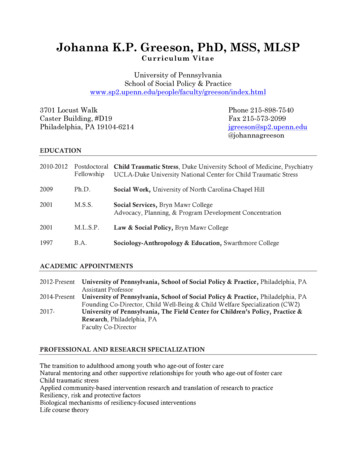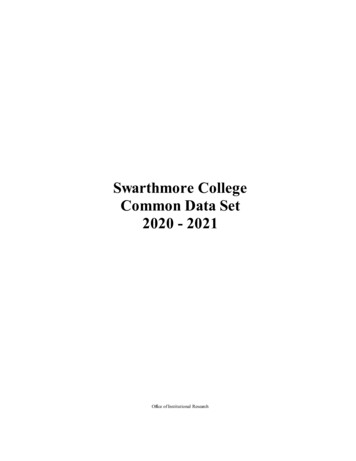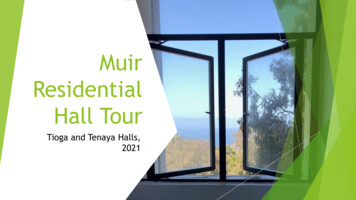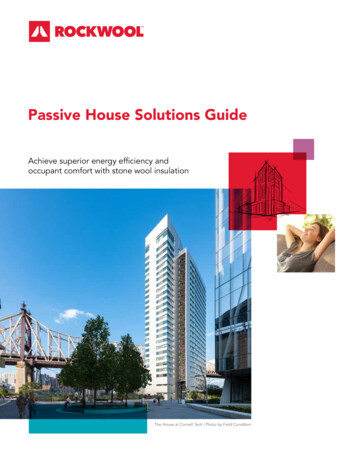
Transcription
The Strawbale House Project at Swarthmore College(1994-1998)This building was an environmentallyinnovative structure, constructedmainly out of load-bearing strawbales.It was built by student volunteers, andby undergraduate student members ofthe 1995 Environmental StudiesCapstone Seminar. The building wasdesigned by students in this seminarunder the direction of Professor E. CarrEverbach (Engineering Department).The course is open to seniorEnvironmental Studies concentrators,and in 1995 it focused on the variousways people can live in the world whileminimizing damage to their naturalenvironment.The house was dismantled during thesummer of 1998. For a detaileddescription of what we learned as wetook it down, click here.The straw bale house simulated a dwelling for a small family, possibly one living in a rural area orIndian reservation. The floor plan consisted of a circular living room, a kitchen, bathroom, utility room,and bedroom; the interior spaces (other than the circular living room) were never implemented.Feasibility studies were performed for several subsystems and designs were produced, but after thebuilding envelope was completed, interest in "finishing" the house waned. The main purpose of theproject was for the students in the Environmental Studies Capstone Seminar to learn about straw baleconstruction by actually building one, and more generally to investigate the tradeoffs betweenenvironmental benefits and practical considerations. The house was not built to serve a need for housingon campus, and ended up serving as a laboratory for analyzing straw bale construction in thenortheastern U.S.
If you'd like to know how we built the structure, click here.As we were preparting to dismantle the house, we undertook an experiment to see if bales could bereplaced in-situ, as the walls were still intact. This process simulates what would have to occur if baleswere damaged by moisture in a strawbale residence.During the four years that the house stood, we measured temperature and humidity using data loggersimplanted in the bale walls. We are compiling the data into meaningful measurements of theperformance of our structure.If you would like to know exactly where the site was on Swarthmore's campus, see this map.Frequently Asked Questions about our project:Why straw?Building from straw is an ancient technique recently rediscovered by environmentalists. The bales arerelatively inexpensive and very thermally insulating (about R 2.1 per inch of wall thickness). There arefew other uses for straw, since, unlike hay, it cannot be used by animals for feed. Furthermore, becauseit decomposes very slowly, it isn't often used for composting. Every year, millions of tons of straw arediscarded or burned in the U.S.How long will it last?The same things that make straw hard to use for other purposes make it ideal for building. When keptdry, straw is very sturdy. Straw has been found, completely intact, in ancient Egyptian tombs. Properlytaken care of, a straw house could conceivably last as long. The biggest enemy of our house is moisture,and the walls have already suffered slight damage when the bales were wetted for several months duringconstruction. On the positive side, however, the straw has already proved able to hold up well to extremeweather conditions, even in an unfinished state. Mildew on the wetted portions of the bales dried andbecame dormant, with no measurable degradation in strength or insulating ability of the bales.Does it burn easily?Because the straw is packed so tightly together (our 46 in. by 22 in. by 16 in. two-string bales weighabout 54 lbs. each, double the density of regular bales), oxygen cannot get into the middle of the bales,and so they do not burn easily. Exposed to enough heat, they will, of course, burn, but less easily than acomparable house built of conventional construction materials.Additional Environmental Costs and Benefits
Although far superior to traditional building methods, the house was far from perfect, environmentallyspeaking. The foundation used concrete and polyethylene foam, environmentally costly substances.However, the foundation was designed to use less concrete than conventional buildings do (seeTechnical Details, below). There was also a small amount of concrete mixed into the stucco placed onthe walls. On the positive side, our straw walls had an average insulation value of R45, which means thatit took very little energy to heat or cool the house.The Future of the ProjectThe Straw Bale House was begun in late Summer, 1994, and the building envelope complete in lateSummer, 1995. Prof. Everbach and his students measured temperature, humidity, moisture content of thewalls, and other relevant parameters continuously since November, 1995. Our goal was to conduct anextended research project on the performance of such structures and on related techniques that promote amore "sustainable" use of resources. Since there are few straw bale houses in areas with cold wetwinters, we hope that the information gathered will be very useful to anyone in interested in building astraw house on the East Coast. When the House was dismantled, the building materials were recycled.How we built it1. The foundation was poured, and steel rods (#4 rebar) were embedded into it.2. Bales were impaled on the rebar, and stacked upwards in staggered rows like bricks. At eachlevel two stakes of bamboo (grown on campus), wood dowels, or steel rebar were pounded in andthrough at least the course below to give the wall strength and stability.3. A plywood frame called a bond beam was placed on the top course of bales upon which the roofbeams bear. The bond beam provides extra stiffness in the walls, especially in the directionperpendicular to the plane of the wall.4. Galvanized steel diamond mesh was pinned around the outside of the walls using "Robertpins" (big Bobby pins), and stucco (a plaster made from of 7 parts common bar sand, 2 partslime, and 1/2 part Portland cement) was applied to protect the walls from moisture.5. The roof was constructed using new and recycled wood. First a "bond beam" was laid on top ofthe walls for additional support. Then "I-beams" (14" TGI) were laid over the entire top of thestructure. Next boards (3/8" OSB) were placed on top of the I-beams, and asphalt roll roofingapplied to the roof. The roof was then attached firmly to the foundation with a series of long rods(#3 rebar with zinc-plated allthread rod welded to the upper end). Finally, the roof was insulatedwith 14 in. blown cellulose insulation made from recycled newspaper (R 45). The finalbuilding was quite strong, and would have lasted decades had we not had to remove it.
Technical DetailsThe concrete foundation of the straw bale house is a variation of a design used by Frank Lloyd Wright: abeam of reinforced concrete cast on a shallow gravel-filled footer with external insulation. Straw baleswere used as forms during the casting process, as shown in the accompanying diagram. The (pink)extruded polyethylene insulation, though not a very environmentally-friendly material, allows theinternal heat of the building to keep the ground from freezing under the foundation and obviates the needfor a deep concrete footing. This shallow frost-protected foundation design has been in use inScandinavian countries and performed excellently in our application. There was no measureable frostheaving, despite solid 4-foot-deep freezes of the ground outside the house.The bales, which were harvested from a field near Allentown, were laid like bricks in courses around theconcrete foundation. The lowest courses were impaled upon the vertical reinforcing bar of thefoundation; higher courses were pierced with bamboo rods harvested from Swarthmore College's ownbamboo groves, as well as with wood and steel rebar spikes. Wire lath holding sand-and-lime stuccocovered the exterior, and minimizes flammability. Conventional doors and windows were built into thestrawbale walls, and a flat shed roof in two oppositely-pitched sections rested on the bondbeams of theuppermost course of wall bales. Twin telephone poles provided stabilization at the juncture of thecircular and rectangular sections, and served to support the upper windows of the clearstory.The Environmental Studies Straw Bale House Project was funded by a generous grant from theEducational Foundation of America, as well as the Roberts Engineering Fund of Swarthmore College.Special thanks are due the Swarthmore administration, Athletics department, Rainbow Awnings, andScott Arboretum, for allowing temporary use of the site and other College resources. If you wish moreinformation about the project, please contact Prof. Carr Everbach .
Campus Map showing Straw Bale HouseThe Straw Bale House at Swarthmore College was located next to the outdoor track, just South of thegrandstand.
Straw Bale House Construction DetailsWe began by designing the floor plan and sectional elevation on a napkin during a mealtimebrainstorming session in Spring, 1994. The rectangular part of the house mirrors that of Steve McDonald'sstraw bale house, and the round part was added for fun and to mirror the round architecture favored bymany tribes of the Lakota and other Native Americans.(Prof. Everbach had spent the Fall semester of 1993 teaching mathematics at Oglala Lakota College,located on the Pine Ridge Reservation near Rapid City, SD). The plans you see here shows the interior asfinished, with interior walls and plumbing facilities (they were never added, since money and studentinterest largely dried up after the building envelope was complete). The wall dimensions are accurate.Due to a suggestion by alocal architect, who worriedthat the mating of ourround room to therectangular room would bea weak spot, we obtainedtwo telephone poles from alocal electric company andused them as stabilizers (asit happens, the straw wallsthey were meant tostabilize were neverconnected to them, and infact, the walls were very
stable without the extrasupport). Having the polesin place, however, allowedus to create a largerclerestory than we hadoriginally envisioned,providing more light andsolar heating gain in amore cathedral-like space.The walls are thus mostly load-bearing, except for the part of the round room from the clerestory to thediameter. Without the two telephone poles, the 12-foot round room wall would probably have been toounstable to bear the asymmetrical weight of the shed roof.For our foundation, weused a shallow frostprotected foundationconsisting of a reinforcedconcrete beam poured ongrade. The 2-in. thickpolystyrene foamboardsunk into the groundabout two feet deepprovided sufficientthermal insulation toprevent water under thefoundation from freezing
and causing heaving.Polystyrene is anenvironmentallyundesirable material, buta small amount of itallowed us to avoid thefour-foot-deep concretefoundations we wouldotherwise have had toemploy. (For more infoabout this foundationsystem, call NAHB at(301) 249-4000).You can see in the above photo that we used straw bales, staked into the ground with rebar, for forms forthe foundation concrete pour. The first two courses were impaled on the rebar we left sticking up throughthe foundation, and subsequent courses were pinned with two stakes per bale of rebar, wood dowels, andbamboo from a local bamboo grove (thanks to the Scott Arboretum). For the round room, bales werebent by placing them over a rock and jumping on them. A plywood bond beam, with two-by-six earshanging down, was fashioned to sit on top of the top course of bales.
Windows and doors were pinned in place with sharpenedwooden dowels and had lintels placed over them to help thembear the roof loads. Lintels consisted of bale-width plywoodpieces with steel angle-iron screwed to both (longer) edges.Racking has turned out not to be a problem, probably becausethe bales we used were especially good (double density: 56 lbs/bale for a 2-string bale).The bales had galvanized steel diamond mesh pinned (with "Robert" pins, since like big bobby pins) to theoutside and covered in sand-and-lime stucco (troweled on). We tried various stucco recipies, and our bestwas: 7 parts bar sand, 2 parts lime, 1/2 part Portland cement, with enough water to reach the rightconsistency. The cement is environmentally undesirable, but a small amount of it goes a long way to keepthe sand and lime together.
You can see Sylvia Kwake '98 cutting bamboo for pinning bale courses together, below. The roof systemwas long pieces of pressed wood "I" beams (TGI), which are very strong and lightweight in the verticaldireciton, bearing upon the bond beams sitting atop the straw walls. Oriented strandboard decking wasscrewed into place on top, drywall (gypsum board) screwed in underneath, and the gap filled with blowncellulose insulation made from recycled newspapers. Since the TGI beams were 14-in. deep, the R-valueof the blown cellulose was calculated to be around 48 (although settling of the cellulose eventuallyproduced a depth of 11 inches, R 40).
As you can see in the image to theleft, the telephone poles were spannedby some two-by-twelves which in turnwere used as the bearing surfaces forthe upper ends of the round room TGIroof members. Highly energy efficientwindows were installed in theclerestory and any wall spaces infilledwith straw bales. The roof decking wascovered in asphalt roll roofing (neitheresthetically or environmentallydesirable, but cheap and relativelyeasy to install with student andvolunteer labor). A whitewash-withpigment color coat was applied to partof the exterior stucco to provide amore uniform appearance, but student(and professor!) energies for estheticniceties gradually waned as thebuilding envelope was complete.In the interior (round room shown here), slate flagstones were potted inrock dust (for later easy removal) over 6-mil poly vapor barrier sittingon 4-in. gravel. The flagstones provide a concrete-free solid surface aswell as a heat storage element, since sunlight from the clearstorywarms them during the day and they re-radiate the heat at night. Thewalls are currently un-stuccoed, but something like a nice light bluepigment would give the interior space a more homey look. Rebartiedowns connect some of the TGI roof beams with the concretefoundation and run up the inside walls from floor to ceiling. The arecurrently exposed but could be encased in plastic pipe or other interiorfinish.Temperature and humidity sensors were implanted in the walls anddata collected during four winters provided an estimate of the net Rvalue of the house: R-45. The building was used as a laboratory for thestudy of Straw Bale construction in the northeastern U.S. andoccationally as a meeting, rehearsal, and party venue.
Proposed subsystems of the Swarthmore Straw Bale HouseThe house was designed to be independent of the energy and water "grid". Water could have been keptin a refillable cistern consisting of two 80-gallon hot water tanks that the Buildings and Grounds staffhad no more use for. Passive solar hot water heaters could have been implemented to circulate and heatthe water in one of the tanks. Likewise wind turbines could have been added to each of the two tops ofthe telephone poles (records of wind speed at the site showed that such a system could have beenpractical) and photovoltaic arrays could have provided DC electrical power to heat or light the interior.The bathroom, which was never implemented, could have contained a waterless "composting" toilet,either purchased or of our own design. Food wastes comparable to what a small family would producewere actually composted both on-site (using a worm-based process: red wigglers) and off-site (using anaerated outdoor heap in the Swarthmore College's Nursery area). A natural landscaping plan was devisedand a proposed graywater treatment facility were considered for the project. No one actually lived in thisbuilding due to zoning and College liability issues but over 3000 people visited it during its four years ofexistance, including building code officials, potential owner-builders of strawbale houses, and manyschoolgroups.The main reason these subsystems were never implemented was that, after the building envelope wascompleted, the students who had built it had graduated or had moved on to other projects. The professor,who had put in over 1000 hours of his own time on the project, was too exhausted to push the finishingtouches. The house served its primary purpose of educating those who built it and also served as alaboratory for the study of the performance of a load-bearing strawbale house in Pennsylvania. Thereseemed little point in making the interior into a livable space since no one was to live there, and, withthe exception of two student dance parties and one staff Holiday party, there was little interest in theCollege community in using the structure for meetings or rehearsals. However meaningful data onperformance of the house itself in our climate was taken and the disassembly process documented forthe benefit of the straw-bale community.
Straw Bale Replacement Experimentsby John Leary '00, Adrian Wilson '00, andProf. E. Carr Everbachwork performed June June 3-4, 1998, writeup June 5, 1998IntroductionIn straw bale structures, mold infestations can become very problematic. In the presence of moisture,molds can readily attack and degrade the cellulose fibers of which straw bales are made, weakening thesupporting walls. If left uninhibited, and if moisture remains, mold spores may spread, furtherweakening walls while inviting infestations of mold-devouring insects. Any water leakage into balewalls, therefore, may necessitate the prompt removal of the plagued bales (unless complete drying ispossible) before wall conditions degrade to a dangerous degree. These experiments investigated thepossibility of in situ straw bale replacement on load-bearing and non-load-bearing walls in the(Nebraska-style) Straw Bale House at Swarthmore College.Two walls were selected in the Straw Bale House; in each wall, four bales from were designated forremoval and replacement, as indicated with X's on the floor plan.Non-load-bearing wall bale replacementIn the non-load bearing wall, Professor E. Carr Everbach selected four adjacent bales (Figure 1).
Workers ascertained the location of the imbedded support rods within the bales (wood tomato stakes,bamboo poles, or steel rebar) by probing the bales with a thin metal strip. Once pinpointed, the locationsof the rods were marked with spray paint on the interior bale surface. Before beginning the bale removalprocess, the bond beam above the non-load bearing wall was propped up by four ten-foot-long two-byfours, two on either side of the wall. The two-by-fours provided just enough lift to support any of theminimal roof weight. Access to the four marked bales was limited to the interior side of the wall, as thestucco and diamond lathe barrier covered the exterior side (Figure 2).Figure 1, showing non-load-bearing wall marked for in-situ bale replacement. This wall is stuccoed onlyon the outside surface.Figure 2, showing non-load-bearing wall outside stucco surface prior to in-situ bale replacement.
Bale extractionBefore removing any individual bales, workers needed to cut the bamboo, wood, and steel spikes thatwere driven through the bales. These rods were located approximately 6-8 inches from the surface of thewall. To reach these supporting rods, the straw constituting the first bale had to be picked out by hand(handsaws aided in loosening the straw to allow for easier access to the rods). Once the rods wereexposed, they were cut with an electric saw ("SawsAll"). Sacrificing the first bale allowed for morecomplete removal of the remaining bales (i.e. maintaining as much of the bales' integrity as possible).The hole left by the removal of the first bale was instrumental in pulling and bending (to a slight degree)the second bale to expose the closest supporting stake. This stake was cut with the electric saw, and asimilar bending and pulling technique was employed to reach remaining support rods. Workers wereable to pull the second bale up off of the last support rod projecting from underneath to complete itsremoval. This second bale was completely intact. The third and fourth bales were removed in similarfashion, using pulling and bending techniques to expose supporting rods. Many of these rods could nowbe pulled out by hand due to the space created by the absence of bales one and two. Rods not looseenough to be pulled were cut as before. Both binding twines of the third bale (upper left) snapped (orwere accidentally cut) during the removal procedure. The bale was recovered in a few large pieces.Because of the large gap created by the three missing bales, bales on the upper tier of the wall requiredadditional support to inhibit collapse. Workers used vertical supports of cut wooden stakes or bamboopoles which had been previously extracted before attempting removal of the fourth bale. The fourth balewas then successfully removed.Figure 3, showing four bales removed, with poles (and plastic milk crate) holding up weight of balesabove removed ones. Visible in the hole is the underside of the galvanized diamond lathe holdingexterior stucco.
Figure 4, showing outside stuccoed wall after removal of bales. The stucco is cracked and would have tobe re-laid after the operation.Bale replacementThe four bales in the non-load bearing wall were replaced in the same order in which they wereextracted. Firm, thin metal sheets placed around the new bales were utilized to reduce friction as theywere slid into place. The first bale fit easily into the bottom gap, with minimal force. Previouslyrecovered steel rebar spikes were then driven through the new bale to reestablish out-of-plane support.Replacing the second bale required an adjustment of our temporary vertical supports to free the gap. Thebale was then shoehorned into place, using the metal sheets as guides, in a similar manner as the first. Itwas also spiked into place. The third and fourth bales required manual, vertical support of upper bales byone worker as a second fitted the replacement bales into place. The spaces left in which new bales wouldbe positioned were significantly smaller than the previous two gaps, and greater amounts of force werenecessary to drive the bales into place (the reduced vertical clearance indicates that compression/settlinghad made the original bales somwhat less thick vertically than the replacement bales). The new baleswere then spiked diagonally from their facing sides up and down into the adjacent bales (Figure 5).
Figure 5, showing completed wall with four new bales inserted. When two-by-fours were removed, thewall settled back to its original configuration with no obvious negative consequences.LaborBale removal and replacement for the non-load bearing wall was accomplished by two workers inapproximately 7.5 hours. It should be noted that the primitive tools used for this project, as well as ourattempts to keep bales intact, slowed progress tremendously. One additional worker would have beenuseful for this bale removal and replacement experiment, especially during the replacement procedure.Load bearing wall bale replacement
Figures 6 and 7, showing hole in load-bearing wall after removal of five bales, and completed wall withnew bales inserted.Bales were selected for removal and replacement in the load bearing wall in a similar manner as for thenon-load bearing wall, while avoiding bales extending into the corner or under the main supporting lintelabove the inner doorway. The bond beam was once again propped up by four two-by-fours, two oneither side of the wall. A temporary support lintel was manufactured using a board, approximately sixfeet long, and a corresponding length of 2-inch angle iron. The board was bevelled using a belt sanderon the side opposite the angle iron and driven into the bale wall (until meeting the support rods withinthe bales) above the bales designated for removal. Two additional two-by-fours propped up thetemporary lintel. This temporary lintel solved the support problem we faced while trying to replace balespreviously in the non-load bearing wall, by not only keeping higher bales from falling, but alsodistributing some of the load to adjacent bales.Bale extractionBales were removed from the load bearing wall in a similar manner to those removed in the non-loadbearing wall, except the workers were not concerned with keeping these bales intact. Extracting bales insmaller portions expedited the process, and also allowed for easier access to hidden support rods. Thisextraction process was also aided by an additional two workers (for a total of four) and access to thebales from both sides of the wall (Figure 6).
Bale replacementBales in the load bearing wall were replaced in a similar manner as those in the non-load bearing wallhad been. However, the bales in the load-bearing wall had supported a greater weight than those in thenon-load bearing walls. Consequently, bales seemed even more tightly compacted. The vertical gaps fornew bales appeared to be significantly smaller than the actual size of the replacement bales (which hadnot been under such constant and prolonged pressure). Accordingly, more force was required to placethe new bales. Again, the advantages provided by four workers and access to both sides of the wall weremanifest. Replacement bales were spiked as before with supporting rods. The temporary lintelsuccessfully braced bales on the upper tier, since they did not require additional support as the upperbales in the non-load bearing wall had. When all four bales were in place and the two-by-fours proppingup the bond beam were removed, the new bales assumed a noticeably tighter configuration (Figure 7).LaborBale removal and replacement for the load bearing wall was accomplished by three to four workers inapproximately 5-6 hours. Progress was aided in this experiment by the existance of the temporary lintel,more workers, and access to both sides of the load-bearing wall.Additional ObservationsInsects discovered during preliminary investigations of the straw bale house include the cellar spider,blue-bottle fly, carpet beetles, a species of social wasp, roughback stink bug, and a small unidentifiedmoth. Swarthmore College instructor Tom Valente identified the specimens recovered, and indicated, inaccordance with our description of the straw bale house, that the cellar spider and the carpet beetles wereprobably permanent dwellers,while many of the other insects were "just passing through". The cellarspider lives in dimly lit, dry environments, making the unoccupied Straw Bale House a perfect home.Carpet beetles feed on dead animal tissue, glues, and even the adhesive on the underside of carpets(hence, their common name). They were most likely feeding on other insects that had visited the strawbale house and died there. While their presence could be an indication that other insect species may bedwelling in the straw bale house, we have yet to document any such infestation. Neither have wewitnessed any rodent nests within the straw walls. It was noted during construction that some waterleakage into the straw bale house resulted in the formation of mold. As the mold traveled farther downthe walls, it was accompanied by hosts of spider nests, apparently following the small insects that mayfeed on the mold.
The Dismantling of Swarthmore's Straw Bale HouseStarting in June, 1998, we began dismantling the Straw Bale House at Swarthmore College. We did thisbecause we felt we had obtained all the information we would likely obtain, other than the very longterm performance of the structure (there was negligible settling or other problems in four years after theinitial few weeks of wall compression). A new tennis facility was to be constructed by the Collegenearby, and the Athletics Department, who had graciously loaned us the site for the Straw Bale House,was interested in reclaiming their land for use as a shot-put and archery area. And finally, theresponsibility for maintaining the house (fixing broken windows vandalized by local hoodlums) restedwith the professor, who had grown weary of worrying about what might happen in or to the house, as itwas policed infrequently.We began with removing the floor, because we did not want the rain to puddle on the moisture barrier inthe floor. Once establishing a way to drain the house, we focused our efforts on dismantling the roofs onthe rectangular and circular rooms. Our next step was to tear down the walls of the circular room, andthen the entire triangle room. We were then able to take down the walls of the rectangular room. Finally,all that remained was the concrete foundation which outlined the shape of the two rooms. Ourfinal task was to find new homes for all the materials.While no humans ever lived in this straw bale house, we found several natural inhabitants.Here is a picture of three of the Straw Bale House Destruction Crew: from left to right, John Leary, JoshBramucci, and Holly Blanchard.
Removing the FloorThe floor consisted of 6 in. of unwashed gravel overlain with 6-mil polyurethane sheet, topped withflagstone slabs potted in about 1/2 in. rock dust (see Figure 1). We began by prying up the flagstoneslabs with a crowbar and transporting them outside with wheelbarrows. The slabs had been sealed downin concrete in one small section of the rectangular room, so we broke those slabs free with a sledgehammer.Figure 1: The four layers in the floor: 6 in. of unwashed gravel overlain with 6-mil polyurethane sheet,topped with flagstone slabs potted in about 1/2 in. rock dustOnce the flagstone had been removed, we removed the thousands of pounds of stone dust. The layer ofstone dust ranged from .5" to 2" in depth. In areas with the
The Strawbale House Project at Swarthmore College (1994-1998) This building was an environmentally innovative structure, constructed mainly out of load-bearing strawbales. . The straw bale house simulated a dwelling for a small family, possibly one living in a rural area or Indian reservation. The floor plan consisted of a circular living .









